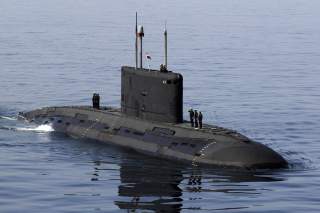Is Iran Getting Ready to Send Warships to the U.S. East Coast?
Yes, this is back in the news—again.
Iran is vowing to dispatch warships to the Atlantic Ocean, which could put them near the U.S. East Coast.
The head of Iran’s navy, Habibollah Sayyari, announced earlier this month that Iranian ships would sail in the "international waters between Europe and the United States."
"The Iranian Navy, which was once only active in the Persian Gulf, is today able to experience five months of voyage and is no more happy with reaching the ten-degree latitude as we believe that our goal should now be navigating in the free waters between Europe and the United States, and this will come true in the near future," Sayyari said.
Recommended: 1.2 Million Casualties: If North Korea Attacked Los Angeles with a Nuclear Weapon
The problem is that Iran's concept of the "near future" seems to be highly elastic. In 2011, Iran also vowed to send warships to the U.S. East Coast. In 2014, Iran did it again. In neither case does it appear that warships ever appeared near American waters. And the ships that Iran promised to send in 2014 drew derision: a forty-five-year-old British frigate that had nearly been sunk by U.S. Navy aircraft in 1988, and a thirty-eight-year-old "helicopter carrier" (actually more of a supply ship) that only carried three helicopters.
Recommended: This Video Shows What Happens if Washington, D.C. Is Attacked with Nuclear Weapons
Sayyari's announcement this month also claimed that Iranian ships had previously entered the Atlantic. "For the first time, the 44th flotilla, comprised of the destroyers Alvand and Bushehr, could sail around the African continent and enter the Atlantic Ocean," Sayyari told reporters at the time.
Recommended: 8 Million People Could Die in a War with North Korea
However, analysts noticed that the destroyers had actually docked at the South African port of Durban. "Durban is located on the Indian Ocean coast, some 932 miles from the Atlantic Ocean," Middle East journal Al-Monitor helpfully pointed out.
Iran's navy consists of a handful of frigates and dozens of small missile boats, plus a few small diesel submarines including three Russian-built Kilo-class subs. It's a regional navy that poses some danger to ships operating in the Persian Gulf, but lacks the long-range vessels—and the equally vital resupply ships—to operate 6,000 miles away near the North American coast.
Indeed, to veteran Middle East military analyst Tony Cordesman, Iran's Atlantic expeditionary force is farcical. Without air cover or modern antiaircraft defenses, those ships wouldn't last long should the U.S. Navy decide they should no longer stay afloat.
Cordesman does believe that Iran could choose to pull off a publicity stunt. "They could send a ship into the Atlantic—not even a warship—and fire a missile. And the global media will give them the attention that Iran wants."
However, Cordesman also warns that Iran does have other ways of exerting naval power. It possesses smart naval mines that could be laid by commercial vessels in coastal areas such as the U.S. East Coast.
Michael Peck is a contributing writer for the National Interest. He can be found on Twitter and Facebook.
Image: Reuters
Recommended: Why North Korea Is Destined to Test More ICBMs and Nuclear Weapons
Recommended: 5 Most Powerful Aircraft Carriers, Subs, Bombers and Fighter Aircraft Ever
Recommended: North Korea Has 200,000 Soldiers in Its Special Forces

